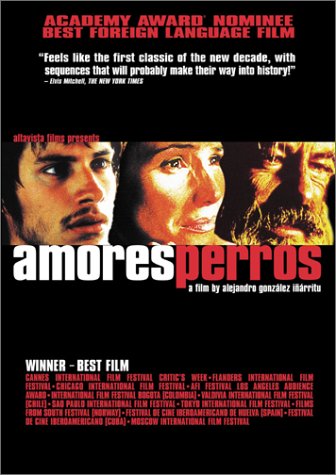
AMORES PERROS
Mexico, 2000, 154 minutes, Colour.
Emilio Echevarria, Gael Garcia Bernal, Goya Toledo, Alvaro Guerrero, Vanessa Bauche, Adriana Barraza.
Directed by Alejandro Gonzalez Inarritu.
Amores Perros was the winner of over fifty awards world-wide. It was the Oscar nomination from Mexico for 2000. It won BAFTA awards as well as awards at Montreal film festival and other festivals around the world.
It is the work of Alejandro Gonzalez Inarritu, a talented Mexican director who went on to make 21 Grams with Sean Penn and Naomi Watts and the Oscar-nominated Babel. He collaborated with his screenwriter Guillermo Arriaga with both films. Arriaga also wrote the screenplay for Tommy Lee Jones’ The Three Burials of Melquiades Estrada.
The film is set in Mexico City. It comprises three separate stories – but the characters are connected by involvement with a car accident. The literal meaning of the title in English would be something like Love’s a Bitch.
The film also offers pictures of different aspects of Mexican society. The first part of the film, with Gael Garcia Bernal, is about the poorer classes and the prevalence of gangsters. The second story is its exact opposite, set in an affluent home, with upper class people who are involved in media. Meantime, there is an enigmatic character, a tramp, who wanders through Mexico City – who once was a hired assassin, fought for the Sandanistas, but now lives a life of asceticism – a kind of witness to what has gone wrong morally with Mexico.
The film uses rather bleached colour photography, giving an impression of Mexico City not so much as a glamorous place but a place where it is very hard to live.
Arriaga always writes screenplays where there are significant time shifts – which means that the audience has to pay attention to see the causality and the links between the various aspects of the stories. Of interest, Adriana Barraza, the mother in this film, was nominated for an Oscar for her performance in Babel.
1.The title? The slang? The actual presence of dogs in the film and their importance? Audience expectations?
2.The work of the writer and the director, their styles, the interlocking of stories, time shifts?
3.The colour photography of Mexico City, bleached, the different neighbourhoods, the world of the poor, the shops and markets, the dogs? The world of the wealthy, comfortable homes, society, media? The world of the streets with El Chivo? The film’s cross-cutting between the different stories? Symbolism – yet realistic stories?
4.The importance of the prologue, the chase?
5.Octavio and his relationship with Susana, Octavio and his brother, the dog, Susana and her love for her husband, her commitment to him, yet the fascination of Octavio? The fights, the injuries, the jealousies? The dogfights, the killing of the other dogs, the deals? The exchange of money, the powers behind the manipulation? Plans? Octavio and his affair? His parents? Susana and her husband, the pregnancy, the abortion? Her final decision, to go? Octavio and his disappointment, the crash, the injuries? Later – meeting Susana? Finally getting on the bus – to where?
6.The dog owner, the fights, the manager? The personalities of these men, tough lives? The deals? The audience at the dogfights? Octavio and his brother, the dog, Octavio and the dogs? The affair, the robberies and the consequences?
7.El Chivo, his past story, scavenging in the streets, the dogs, watching the girl, the obituary notice, the funeral and the clash, his being an assassin, his family, his fighting for the Sandanistas in Nicaragua, his imprisonment? An intellectual, getting out of prison, his rebellion, going away from everyone? The ideologies? Prison, death in the street, the stalking? The dog and his care for it? Getting the money? The impact of the crash? His change, dressing better, transforming himself, writing his letter to the girl?
8.The wealthy couple, driving, the child, tensions, advertising agency, at home? Work, agent, affairs, television interviews? The actor? Sexual morality, infidelity? The house, the divorce? The accident and the consequences? The hospital sequence, the glamorous woman, depending on her looks, the disfigurement? The tension, the man coming, the clash, the advertisements being dropped, the sense of despair and loss?
9.How pessimistic was the film, in its portrait of hard lives, whether poor or rich? The range of stories? The issues of loss, regret, greed, lust, violence? Mexican style?